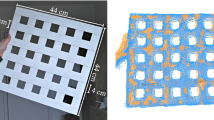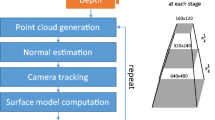Abstract
Since the beginning of 3D computer vision problems, the use of techniques to reduce the data to make it treatable preserving the important aspects of the scene has been necessary. Currently, with the new low-cost RGB-D sensors, which provide a stream of color and 3D data of approximately 30 frames per second, this is getting more relevance. Many applications make use of these sensors and need a preprocessing to downsample the data in order to either reduce the processing time or improve the data (e.g., reducing noise or enhancing the important features). In this paper, we present a comparison of different downsampling techniques which are based on different principles. Concretely, five different downsampling methods are included: a bilinear-based method, a normal-based, a color-based, a combination of the normal and color-based samplings, and a growing neural gas (GNG)-based approach. For the comparison, two different models have been used acquired with the Blensor software. Moreover, to evaluate the effect of the downsampling in a real application, a 3D non-rigid registration is performed with the data sampled. From the experimentation we can conclude that depending on the purpose of the application some kernels of the sampling methods can improve drastically the results. Bilinear- and GNG-based methods provide homogeneous point clouds, but color-based and normal-based provide datasets with higher density of points in areas with specific features. In the non-rigid application, if a color-based sampled point cloud is used, it is possible to properly register two datasets for cases where intensity data are relevant in the model and outperform the results if only a homogeneous sampling is used.
















Similar content being viewed by others
References
Castelló P, Chover M, Sbert M, Feixas M (2014) Reducing complexity in polygonal meshes with view-based saliency. Comput Aided Geom Des 31:279–293. doi:10.1016/j.cagd.2014.05.001
Cignoni P, Montani C, Scopigno R (1997) A comparison of mesh simplification algorithms. Comput Graph 22:37–54
Fritzke B (1995) A growing neural gas network learns topologies, vol 7. MIT Press, Cambridge, MA, pp 625–632
Gangwal OP, Berretty RP (2009) Depth map post-processing for 3D-TV. In: Digest of technical papers—IEEE international conference on consumer electronics. doi:10.1109/ICCE.2009.5012253
Han H, Han X, Sun F, Huang C (2015) Point cloud simplification with preserved edge based on normal vector. Opt Int J Light Electron Opt. doi:10.1016/j.ijleo.2015.05.092. http://linkinghub.elsevier.com/retrieve/pii/S0030402615004052
Henry P, Krainin M, Herbst E, Ren X, Fox D (2012) RGB-D mapping: using Kinect-style depth cameras for dense 3D modeling of indoor environments. doi:10.1177/0278364911434148
Katz S, Tal A (2013) Improving the visual comprehension of point sets. In: Proceedings of the IEEE computer society conference on computer vision and pattern recognition, pp 121–128. doi:10.1109/CVPR.2013.23
Langmann B, Hartmann K, Loffeld O (2011) Comparison of depth super-resolution methods for 2D/3D images. Int J Comput Inf Syst Ind Manag Appl 3:635–645
Lee KH, Woo H, Suk T (2001) Point data reduction using 3D grids. doi:10.1007/s001700170075
Li Y, Sun L (2010) A novel upsampling scheme for depth map compression in 3DTV system. In: 28th Picture coding symposium, PCS 2010, pp 186–189. doi:10.1109/PCS.2010.5702456
Mamou K, Ghorbel F (2009) A simple and efficient approach for 3D mesh approximate convex decomposition. In: Image processing (ICIP), 2009 16th IEEE international conference on. doi:10.1109/ICIP.2009.5414068
McNeely WA, McNeely WA, Puterbaugh KD, Puterbaugh KD, Troy JJ, Troy JJ (1999) Six degree-of-freedom haptic rendering using voxel sampling. In: Computer Graphics (SIGGRAPH Proceedings), pp 401–408. doi:10.1145/1198555.1198605
Mora-Mora H, Mora-Pascual J, García-Chamizo JM, Jimeno-Morenilla A (2006) Real-time arithmetic unit. Real-Time Syst 34(1):53–79
Myronenko A, Song X (2010) Point set registration: coherent point drift. IEEE Trans Pattern Anal Mach Intell 32(12):2262–2275. doi:10.1109/TPAMI.2010.46
Nehab D, Shilane P (2004) Stratified point sampling of 3D models. In: Proceedings of the first eurographics conference on point-based graphics, SPBG’04. Eurographics Association, Aire-la-Ville, Switzerland, pp 49–56. doi:10.2312/SPBG/SPBG04/049-056
Newcombe RA, Davison AJ, Izadi S, Kohli P, Hilliges O, Shotton J, Molyneaux D, Hodges S, Kim D, Fitzgibbon A (2011) KinectFusion: real-time dense surface mapping and tracking. In: 2011 10th IEEE international symposium on mixed and augmented reality. IEEE, pp 127–136. doi:10.1109/ISMAR.2011.6092378
Orts-Escolano S, Garcia-Rodriguez J, Morell V, Cazorla M, Garcia-Chamizo J (2014) 3d colour object reconstruction based on growing neural gas. In: Neural networks (IJCNN), 2014 international joint conference on, pp 1474–1481
Orts-Escolano S, Morell V, Garcia-Rodriguez J, Cazorla M (2013) Point cloud data filtering and downsampling using growing neural gas. In: The 2013 international joint conference on neural networks, IJCNN 2013. Dallas, TX, USA, pp 1–8
Ryde J, Hu H (2010) 3D mapping with multi-resolution occupied voxel lists. Auton Robots 28:169–185. doi:10.1007/s10514-009-9158-3
Scharstein D, Szeliski R (2003) High-accuracy stereo depth maps using structured light. In: 2003 IEEE computer society conference on computer vision and pattern recognition, vol 1, Proceedings. doi:10.1109/CVPR.2003.1211354
Schnabel R, Klein R (2006) Octree-based point-cloud compression. In: SPBG, pp 111–120. doi:10.2312/SPBG/SPBG06/111-120
Schwarz H, Marpe D, Wiegand T (2007) Overview of the scalable video coding extension of the H.264/AVC standard. IEEE Trans Circuits Syst Video Technol 17:1103–1120. doi:10.1109/TCSVT.2007.905532
Shi BQ, Liang J, Liu Q (2011) Adaptive simplification of point cloud using k-means clustering. Comput Aided Des 43:910–922. doi:10.1016/j.cad.2011.04.001
Acknowledgments
This study was supported in part by the University of Alicante and Spanish government under Grants GRE11-01 and DPI2013-40534-R.
Author information
Authors and Affiliations
Corresponding author
Rights and permissions
About this article
Cite this article
Saval-Calvo, M., Azorin-Lopez, J., Fuster-Guillo, A. et al. Evaluation of sampling method effects in 3D non-rigid registration. Neural Comput & Applic 28, 953–967 (2017). https://doi.org/10.1007/s00521-016-2258-z
Received:
Accepted:
Published:
Issue Date:
DOI: https://doi.org/10.1007/s00521-016-2258-z




